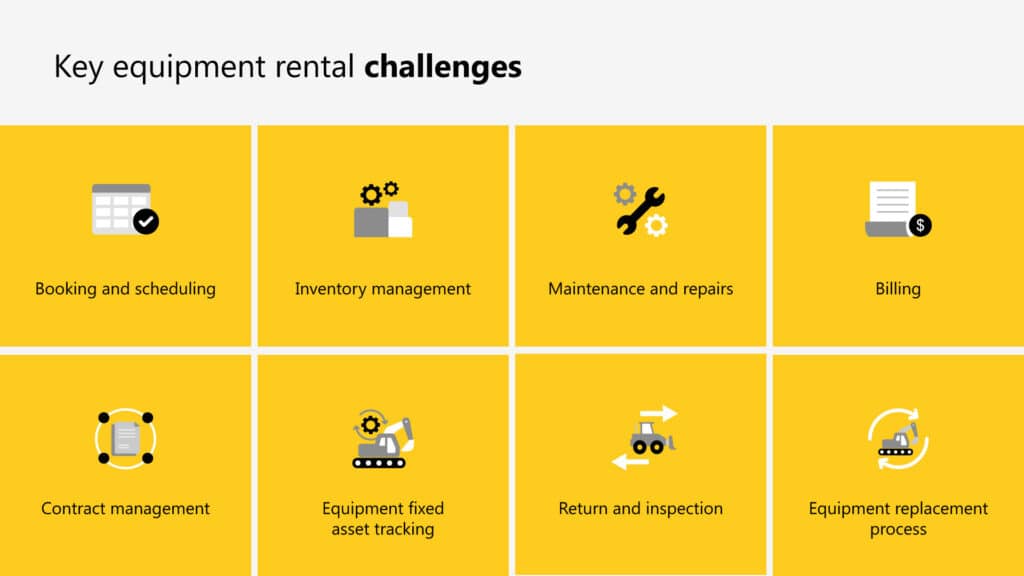The equipment industry grapples with many challenges related to rental operations due to the inherent complexity of its offerings.
But, you might wonder, how complicated could it really be? It seems like a straightforward business, doesn’t it? Well, think again!
Managing the vast array of equipment types and sizes poses a logistical challenge. Coordinating the scheduling and availability of this diverse machinery, each with unique specifications and maintenance needs, demands a sophisticated management approach.
The capital-intensive nature of equipment also makes efficient utilization imperative. Balancing the demand for various equipment types while minimizing downtime and maintenance costs is a perpetual challenge.
The industry itself, being high-risk, operates within a framework of stringent safety and compliance regulations. Adhering to these standards adds layers of complexity to rental processes, requiring businesses to stay vigilant and invest in safety measures.
Additionally, the technology landscape is rapidly evolving, introducing challenges and opportunities for integrating advanced solutions like telematics and IoT for equipment monitoring and predictive maintenance.
And we’re not done yet. The fluctuating landscape of construction projects and industrial ventures creates unpredictable demand, prompting rental businesses to stay agile in adjusting their fleets and operations accordingly.
In essence, the intricate interplay of logistical, financial, regulatory, technological, and market-driven factors renders the heavy equipment rental industry uniquely challenging.
Now that we understand the complex nature of rental for equipment businesses, let’s dive into some of the challenges they are facing daily.
Rental challenges faced by equipment businesses
Equipment businesses contend with a spectrum of challenges stemming from both internal and external factors. Operating within a high-risk industry, these businesses navigate stringent regulations and policies surrounding safety, maintenance, and other compliance measures. They must remain vigilant and proactive in addressing these challenges to sidestep potential fines and penalties that could have significant financial implications.
Internally, these businesses grapple with intricacies such as efficient booking and scheduling, inventory management, and the imperative need for streamlined maintenance and repairs. The diversity in their equipment catalog requires meticulous categorization and tracking, demanding operational precision to avoid underutilization or shortages.
Furthermore, the complex logistics associated with heavy equipment, including specialized transportation and handling, pose internal logistical challenges that demand strategic solutions.
Externally, equipment businesses are subject to the fluctuating demands of the market, influenced by seasonal trends and broader industry shifts. These external factors necessitate agile inventory management strategies to optimize resources effectively. Additionally, the variable pricing structures inherent in heavy equipment rentals, dependent on factors like usage and project duration, present challenges in accurate and transparent billing.
Key equipment rental challenges

These internal and external challenges include:
Booking and scheduling
Complex logistics: Heavy equipment often requires specialized transportation and handling. Coordinating logistics for timely deliveries and pickups can be challenging, especially when dealing with large and diverse fleets.
Project synchronization: Aligning equipment availability with project timelines is crucial. Delays in booking or scheduling can disrupt project timelines, leading to financial losses for both the rental company and the customer.
Inventory management
Diverse equipment catalog: Managing a diverse range of heavy equipment, each with unique specifications and maintenance requirements, poses a significant challenge. Effective categorization and tracking are essential for streamlined operations.
Seasonal demands: Fluctuations in demand based on seasons or industry trends require businesses to optimize their inventory to prevent underutilization or shortages.
Maintenance and repairs
Downtime costs: Heavy equipment downtime can be costly for both the rental company and the customer. Ensuring proactive maintenance schedules and swift repair processes is vital to minimize disruptions.
Compliance challenges: Heavy equipment often comes with stringent safety and regulatory requirements. Managing compliance checks, certifications, and inspections adds another layer of complexity.
Billing
Variable pricing structures: Billing for heavy equipment rentals often involves complex pricing structures based on factors such as usage, project duration, and additional services. Ensuring accurate and transparent billing is crucial for maintaining customer trust.
Dispute resolution: Discrepancies in billing can lead to disputes. Having a robust system to track and resolve billing discrepancies is essential for customer satisfaction.
Contract management
Legal complexity: Heavy equipment rental contracts can be legally intricate, involving detailed terms and conditions. Managing these contracts efficiently, including amendments and renewals, is critical.
Insurance requirements: Ensuring that rental agreements include appropriate insurance provisions to protect both parties from potential liabilities adds an extra layer of complexity.
Equipment fixed asset tracking
Depreciation and valuation: Tracking the depreciation and valuation of heavy equipment assets accurately is vital for financial reporting and strategic decision-making.
Theft prevention: Heavy equipment is susceptible to theft. Implementing robust tracking systems can help prevent theft and aid in recovery efforts if necessary.
Return and inspection
Timely return: Coordinating the return of equipment on time is crucial for both scheduling and billing. Delays in returns can disrupt subsequent rentals and lead to financial implications.
Thorough inspection: Conducting thorough inspections upon equipment return is essential for identifying damages and ensuring that the equipment is in a suitable condition for the next rental.
Equipment replacement process
Minimizing downtime: Efficiently managing the replacement process is essential to minimize downtime for customers waiting for equipment. This involves strategic planning for timely transfers and replacements.
Optimizing fleet: Balancing the need for replacing aging equipment with the associated costs requires strategic decision-making to ensure a modern and efficient fleet.
Ultimately, the challenges faced by equipment businesses demand a proactive approach that integrates technological solutions and strategic decision-making. By effectively addressing both internal and external challenges, businesses can not only ensure regulatory compliance but also optimize their operations for enhanced efficiency and sustained success in a high-stakes industry.
Overcoming these challenges requires a comprehensive rental management solution that addresses the specific needs and nuances of the heavy equipment industry. A solution like Annata’s A365 can play a crucial role in streamlining operations, enhancing efficiency, and ensuring customer satisfaction in heavy equipment rental businesses.
Seamless rental operations from beginning to end with A365
A365 is your comprehensive solution for effective equipment rental management, enhancing operational efficiency, and delivering exceptional customer service. With features such as fleet management, asset tracking, bookings, and maintenance tools, it accelerates the digital transformation of your rental operations.
With Microsoft Dynamics 365 as the backbone, A365 creates personalized rental experiences and provides the necessary features for monitoring and analyzing the entire process, from rental and periodic invoicing to returns and maintenance, ensuring operational excellence throughout your equipment rental business.

A365 presents an innovative approach to equipment rental management with its comprehensive suite of features including:

Is your equipment business grappling with rental operation optimization? Connect with our team of Annata experts for a personalized discussion to explore how we can help you power new possibilities for your business.
For more details on A365’s cutting-edge rental capabilities, download our comprehensive factsheet and unlock the potential for transformative growth.








